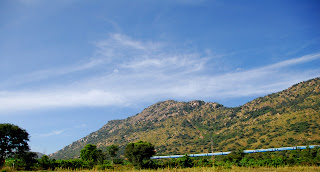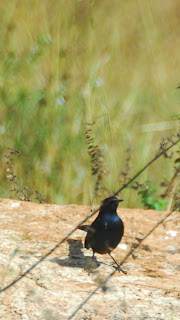This is my last post for the year 2010. So first of all, Happy New Year to everybody. I hope 2011 brings you all joy and success.
It has been a year of ups and downs for me but I've managed to pull through without too much damage. There were one or two times when I did wonder what was happening but thanks to my friends, my photography, and my bird watching jaunts, I did maintain some semblance of sanity.
Christmas Eve saw five of us making our way through a misty, freezing morning to Makalidurga. For the most part, this is a little train station near Doddaballapur just about 70 km from Bangalore City. The charming station is all that proclaims the few houses, mountains, and myriad fields that dot the landscape. On top of the hill is a fort that contains temples but my knowledge of it is limited to what I've been told and a few pieces of information from the Internet.
During the drive up, we crossed that magical line that had us suddenly breaking through the mysterious foggy scenes around us to bright, sunlit skies. A few vehicles threatened us as we stepped out of the SUV, stretched and strode across the road to examine some spider webs just off the road. The blue skies were adorned with feathery clouds that streamed across.
Uloborid spider webs glistened like little bowls of frosted glass while a Kidney Garden Spider spun its morning web, quite unconcerned that five human beings were peering at her with curiosity.
Deepa made a short video of this spider's web making efforts while the rest of us reveled in the welcome sunshine.
A short drive down the road brought us past the quaint little Makalidurga railway station. However, at that moment, the lake further down interested us and we headed there in a hurry to see if we could spot any waterbirds.
Indian Robins, silverbills, pied bushchats, laughing doves (or little brown doves) greeted us. But there wasn't a single water bird to be see. It took quite a while to find even a lesser egret that flew slowly across the water and disappear over the horizon.
A pair of lapwings kept watch. As we tried to get closer to them, they scolded us with their "Did you do it?" calls and took off.
Chandu excitedly pointed out the trains passing by in the distance. His enthusiasm was quite infectious, so much so, that I, who haven't been very fascinated by trains, found myself photographing them if only to show the majestic backdrop of the mountains.
We made our way back to the SUV and drove to the station. On our way to the station, a pair of button quail burst out from the brush and sped across the road to disappear into the bushes on the other side. Anil braked hard and we went into such raptures over the quail that we didn't notice an inter-city bus that had had to brake hard behind us to avoid totaling Anil's car.
Close to the station, Deepa wandered away to photograph the station itself and the surroundings, the remaining four of us struggled with a flat tyre. It was quite disappointing to find out that there wasn't a path leading to the mountains from where we were. However, a helpful villager pointed us to the right path a short drive away from where we were and told us we could access the mountains from there.
A profusion of birds greeted us as we parked the car below a convenient tree and stepped out. In the far distance, a few trucks and buses went by, their engines a muted roar that barely reached us. The serene mountains were behind us but hunger beckoned. Anil, who had the foresight to pack a few snacks from V.B. Bakery the previous night, brought out buns which had been loaded with jam or butter and peanuts.
Happily we munched on these while a stray dog from the nearby village followed each of us expectantly.
A male Indian robin hopped around about 10 feet away picking off insects from a rock. He kept an eye on us as we circled him with our cameras. Infuriatingly, he managed to keep a little vegetation between him and our cameras before he flew off. Farther away on an electric wire, a male pied bushchat sat, quite unconcerned by the rash of clicking cameras that focused on him.
Chandu spotted a kestrel in the distance and Deepa and Prashanth attempted to get close enough to photograph it. However, the bird spotted them creeping up and took off, wheeling around in a great circle to roost again in a tree somewhere else. Chandu and I kept an eye on it and this time, I tried my luck in getting close enough but it wasn't anywhere to be seen.
A pair of shikras next made their appearance as they flew quickly overhead and disappeared in the vegetation that covered the mountainside. As we tried to find them, the kestrel emerged. How it had flown to the mountain unseen by us was beyond me but Chandu's sharp eyes saw it perched on the very top of a tree on the mountain.
By the side of the path that led across the railway line was a tree that was filled with purple rumped sunbirds. The birdsong from this tree alone kept me quite entranced for a while but the pull of the mountain was too strong. And the kestrel was a challenge as well.
Wisely perhaps Anil, Prashanth, and Deepa decided to stay behind while Chandu and I scrambled up the mountain. This was the one that faced the Makalidurga mountain and was easier to climb. Careful not to slip on the gravel and leaf litter, Chandu and I made our way to the tree where the kestrel was perched but it took off again seeing the two of us.
We climbed further up the mountain and settled on a few rocks there admiring the vista below all the while hoping futilely that the kestrel would return to its perch. Down below, the un-metaled road wound away back to the highway. In the far distance, cattle lowed as they were driven to the village and into the mountainside where they would graze. Trees to our left hid the little temple that formed the life of the handful of people there. These trees were playing host to monkeys and parakeets. We watched from our vantage point as Deepa disappeared into the cool shady environs of the temple.
As we sat there admiring the view, a small green bee-eater appeared and settled on a branch slightly below us some 25 feet away. Its chestnut coloured head gleamed iridescent in the sunshine while the beautiful blue green colours on its face seemed to glow. To our delight, it stayed there for quite a while before flying off in pursuit of some insect that only its sharp eyes could see.
Deciding to take a different path down,we set off and found ourselves trying to make our way around the summit of the mountain we were on. It was little more than a goat path but still slippery so we gingerly stepped on the sloping sides as we went on down. We reached a point just above the temple when a Sirkeer Malkoha flew past swiftly. Chandu and I watched and waited till it had settled and tried to creep up on it but the wily bird flew first into a bush where it was all but invisible and then further away to a bush. It scuttled quickly into the bush and emerged on the left where it captured something edible. It was moving too fast, but we did manage to get a glimpse of the scarlet beak and the pale blue brows just above the eyes.

As we were watching it, a raptor swooped down to our left and Chandu, being alert, spotted it as it took off again. It was a pale coloured bird and I mistakenly, and stubbornly, insisted that it was a pallid harrier. Deepa later suggested it was a falcon in pale morph.
Jubilant over having seen the Malkoha and the raptor, we quickly went down to join Deepa in the temple where she was photographing the carpenter bees. An amusing incident occurred here that I will keep for another day.
We made our way back to the car where Anil and Prashanth joined us, having exhausted all probable angles of photographing the sun birds. We had a leisurely lunch off some wonderful
bisi bele bhath that Deepa had woken up very early in the morning to make. Just as we returned to the highway, Deepa spotted a bush lark on the side of the road. I was too far to get a photograph and had to be content with what I could see through the rear windshield. A short while later, having deviated to take the road to Ghati Subramanya temple, we spotted a black-shouldered kite regally resting on an electric cable. Closer to the temple, Chandu's sharp eyes spotted a shikra perched on top of a telegraph pole. With both the pole as well as the bird being the same colour, the shikra was almost invisible. How Chandu had spotted it while we were on the move still escapes me.
Here's to a lot more posts and a lot more birding in 2011. Cheers everybody.















 It's the views around that are fantastic. The
It's the views around that are fantastic. The  Birds abound. They seem to be more fearless here than in places closer to the city. Babblers often cross your path,
Birds abound. They seem to be more fearless here than in places closer to the city. Babblers often cross your path, 








